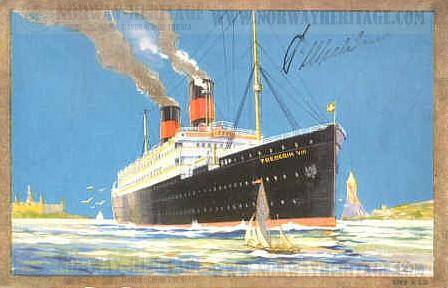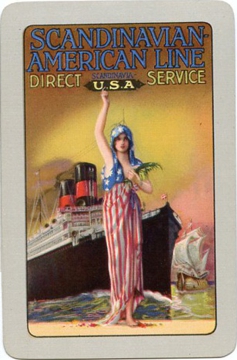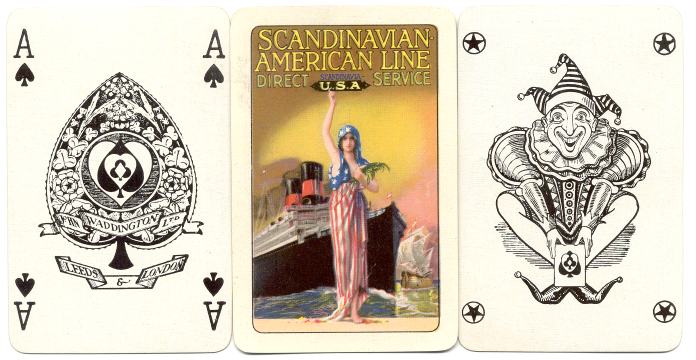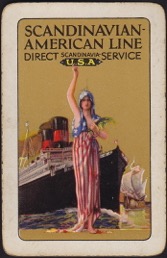A WADDINGTON
SURPRISE
-2-
The Thingvalla
Line, founded in 1879, maintained a direct line between Scandinavian ports and
America. The line was successful because it gave Scandinavian emigrants the
opportunity to start their journey to the US without having to go to Germany or
England. In 1898 the DFDS (Det Forenede Dampskibs Selskap / “The United
Steamship Company”) took over the Thingvalla Line and the passenger line was
continued under the name Scandinavian American Line. Their route started off in
Copenhagen, Denmark, where –according to the box of the deck- the company was
situated, and then called on Kristiania (Oslo) and Kristiansand (both in Norway)
before crossing the ocean to New York. The passenger service was discontinued in
1935.
At this point
the dating of the deck had been narrowed down to somewhere between 1923 and
1935. In an attempt to further pinpoint the date we took a closer look at the
only clue left: the ship that was depicted on the back of the cards.
The original 4 ships of the Thingvalla Line
were small and older vessels, made between 1873 and 1884. The fleet was expanded
with another ship in 1897, just before the take-over by the DFDS. After the
take-over it was still found necessary to further modernize the fleet and new
ships were ordered. In 1901, 1902 and 1903 the sister ships SS Oscar II, SS
Heilig Olav and SS United States were added and in 1913 the SS Frederik VIII
completed the fleet.
Finding the ship that is depicted on the backs of
the cards was relatively easy. Checking the photos of all the ships of the
Scandinavian American Line, there was only one with two pipes on top: the SS
Frederik VIII.
|

|
The SS Frederik VIII had a tonnage of 11,850
gross and was build by AG Vulcan from Hamburg, Germany.
It was launched on May 27, 1913 and had its
maiden voyage for the Scandinavian American Line on February 5th,
1914.
For her last voyage she departed from New York on
December 7th 1935 to Copenhagen.
In November 1936 she was sold to The Hughes
Bolckow Shipbreaking Co. for scrapping at Blyth.
*Picture taken from norwayheritage.com
|
So that information didn’t really change anything in dating the deck.
Although we first thought that the total design on the back could suggest a
maiden voyage, this was contradicted by the fact that the Frederik VIII’s
maiden voyage started on Feb. 5, 1914, about 9 years before Waddington produced
it’s first playing cards. So we checked if any special occasions had taken
place, important enough to be supported or commemorated by this deck. Alas, the
ship’s logs don’t give any conclusive information. So we got stuck and can
only give a choice between a number of dates that might have been the reason for
publication of this deck:
1/ the 25th anniversary of the Scandinavian
American Line in 1923.
2/ the 10th anniversary of the ship in 1924.
3/
the first alternation to cabins and 3rd class only in 1925.
4/ the
addition of a tourist class to these in 1929.
5/ hard to imagine, but still
possible, is that this deck was presented as a goodbye gift for her last voyage
to the USA on Nov. 22, 1935.
The deck consists
of 52 cards, one joker and a blank card. It has solid gold edges and came in a gray
box with a card glued -face down- on the bottom and the name of the company
embossed in the lid.
-1-
-2- -3- -4-
XPOHOME



